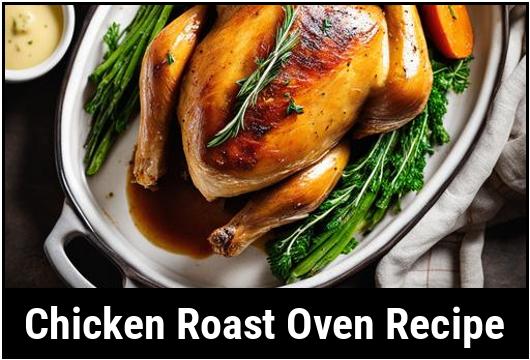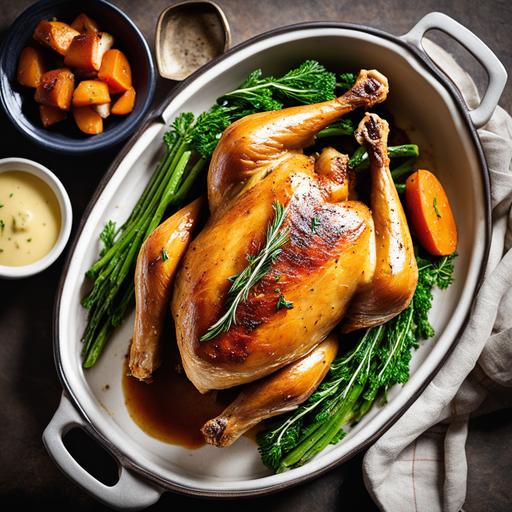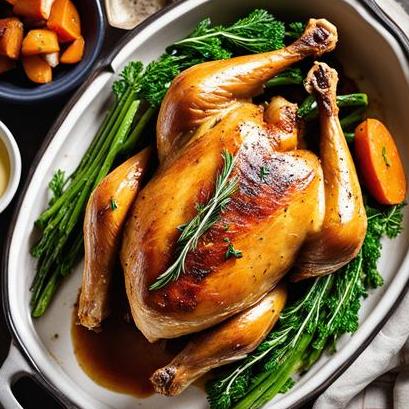
The Perfect Chicken Roast Oven Recipe: Unleashing Culinary Excellence
Are you ready to embark on a culinary journey that will ignite your taste buds and leave your guests wanting more? Today, we are delving into the world of chicken roast oven recipes, exploring the art of creating a succulent and flavorful roast chicken that will be the centerpiece of any meal. In this comprehensive and in-depth article, we will delve into every aspect of this mouthwatering dish, from food science to culinary details, selection to cleaning and preparation, tips to variations, doneness checks, and everything in between. So, let’s roll up our sleeves and embark on this delicious adventure!
Food Science: Understanding the Magic Behind Roast Chicken
To truly master the art of chicken roast, it is important to understand the science behind this magical transformation. Roasting intensifies the chicken’s flavors while ensuring a crispy exterior and tender interior. Let’s dive into the culinary details and explore the key elements that take your roast chicken to the next level:
Maillard Reaction – The Secret to Flavorful Goodness
One of the essential phenomena in this flavorful journey is the Maillard reaction. This chemical reaction occurs when heat is applied to proteins and sugars, resulting in color changes and the irresistible aroma and taste we associate with roasted meats. The Maillard reaction is what creates that beautiful golden-brown crust on your chicken, providing a delightful blend of flavors and textures.
Moisture Retention – The Key to Tenderness
To achieve a perfectly juicy and tender roast chicken, it is crucial to retain moisture throughout the cooking process. Chicken meat naturally contains around 75% water, but during roasting, loss of moisture can occur. This can be mitigated by various cooking techniques, which we’ll explore later in this article.
Selecting the Ideal Chicken: Freshness and Quality Matter
Fresh is Best
When it comes to roast chicken, freshness is paramount. Choosing a fresh chicken ensures optimal flavor and tenderness, creating a foundation for a delectable dish. Here are a few tips to consider when selecting your chicken:
-
Visit a trusted butcher or farmer’s market where you can find freshly butchered chickens.
-
Look for plumpness and firmness in the chicken’s flesh.
-
Check for a pleasant, slightly sweet aroma, indicating freshness.
Organic, Free-Range, and Antibiotic-Free
For those seeking an even higher quality chicken, organic, free-range, and antibiotic-free options are worth exploring. These chickens are raised with a focus on animal welfare and tend to have a superior taste and texture.
Preparing for Success: Cleaning and Preparing the Chicken

Cleaning the Chicken
Before embarking on your epic chicken roast adventure, proper cleaning is essential. Follow these steps to ensure you’re starting with a clean canvas:
-
Remove the chicken from its packaging and discard any giblets or neck that might be included.
-
Rinse the chicken thoroughly under cold water, inside and out, to remove any lingering debris.
-
Pat the chicken dry with paper towels to ensure a crispy skin after roasting.
Preparing the Chicken
Proper preparation is the foundation for a successful roast chicken. Follow these guidelines to make your chicken absolutely irresistible:
-
Trussing: Trussing the chicken (tying the legs together) helps the chicken retain its shape during roasting, ensuring even cooking and a beautiful presentation.
-
Seasoning: Season the chicken generously inside and out with salt and pepper. This simple yet crucial step enhances the flavor of the meat.
-
Optional Marinade: If you’re feeling adventurous, marinating the chicken overnight can infuse it with incredible flavors. Consider using a mixture of herbs, garlic, lemon juice, and olive oil to create a tantalizing marinade.
Tips and Tricks: Elevating Your Roast Chicken Game
Now that you have learned the culinary elements and prepared the chicken, it’s time to take your roast chicken to new heights with some tips and tricks:
Golden Crispy Skin: The Ultimate Crowning Glory
Achieving a perfectly golden, crispy skin is a goal every roast chicken aficionado aspires to. Here are a few techniques to help you accomplish this:
-
Butter Basting: Basting the chicken with melted butter during the cooking process will enhance both flavor and crispiness.
-
High-Heat Blast: Starting the cooking process at a higher temperature (around 425°F) for the first 15 minutes can help create an enhanced golden crust.
Moisture Enhancement: Say Goodbye to Dry Chicken
Nobody likes dry chicken—retaining moisture throughout the cooking process is key to achieving delightfully tender meat:
-
Stuffing the Cavity: Adding aromatics, such as lemon wedges, garlic cloves, or fresh herbs, enhances moisture and imparts delightful flavors during the cooking process.
-
The Water Pan Technique: Placing a pan filled with water on the lower rack of the oven can create steam that helps keep the chicken moist during roasting.
Checking for Doneness: Perfect Timing is Everything
Determining when your roast chicken is perfectly cooked is an art, and various methods can help you achieve success:
Thermometer: The Accurate Path to Deliciousness
Using a meat thermometer is the most reliable way to determine doneness. Insert the thermometer into the thickest part of the chicken thigh, ensuring it doesn’t touch the bone. The chicken is safe to consume when it reaches an internal temperature of 165°F (75°C).
Visual Cues: The Time-Tested Approach
If you prefer a more traditional approach, visual cues can provide guidance:
-
Golden-Brown Perfection: A beautifully golden-brown color on the skin indicates that your chicken is nearing completion.
-
Juices Running Clear: When pricking the thigh with a fork or knife, clear juices should run out, indicating that your chicken is cooked through.
The Quintessential Chicken Roast Oven Recipe: Your Ticket to Gastronomic Glory

Now that you’ve mastered the culinary science, selection, cleaning, preparation, and essential tips, it’s time to unleash the ultimate chicken roast oven recipe. Gather your ingredients and follow these step-by-step instructions for a mesmerizing roast chicken:
Ingredients:
-
1 whole chicken (3-4 pounds)
-
Salt and pepper to taste
-
4 tablespoons butter
-
2 garlic cloves, minced
-
1 lemon, cut into wedges
-
Fresh herbs (thyme, rosemary, sage), chopped
Instructions:
-
Preheat your oven to 375°F (190°C).
-
Truss the chicken to ensure even cooking and a beautiful presentation.
-
Season the chicken generously with salt and pepper.
-
In a small bowl, combine the minced garlic with the softened butter.
-
Gently loosen the chicken skin and spread the garlic butter mixture evenly under the skin.
-
Place the lemon wedges and fresh herbs into the chicken cavity.
-
Transfer the chicken to a roasting pan, breast side up.
-
Roast the chicken for approximately 60-75 minutes, or until the internal temperature reaches 165°F (75°C).
-
During the last 15 minutes of cooking, baste the chicken with pan juices or melted butter to enhance flavor and crispiness.
-
Remove the chicken from the oven and let it rest for 15 minutes before carving.
-
Serve your masterpiece with your favorite side dishes and enjoy!
The Pitfalls: Overcooking and Undercooking
Even the most experienced chefs can occasionally fall into the pitfalls of overcooking or undercooking their roast chicken. Here’s what to watch out for:
Overcooking: The Culinary Tragedy
Roasting a chicken for too long can result in dry, flavorless meat that leaves your guests underwhelmed. Ensure you follow the recommended cooking times and use a meat thermometer to prevent overcooking.
Undercooking: The Culinary Safety Hazard
Undercooking chicken poses a risk of foodborne illnesses such as Salmonella. Always use a reliable cooking method, such as a meat thermometer, to confirm doneness before serving.
Variations and Adventure: Tailoring the Recipe to Your Taste
While the classic roast chicken is a culinary masterpiece, don’t be afraid to experiment with variations to suit your taste buds. Here are a few ideas to get you started:
-
Smoked Paprika and Lime: Replace the traditional seasoning with a blend of smoked paprika, lime zest, and a pinch of cayenne pepper for a bold and tangy twist.
-
Herb Infused: Create an herb-infused extravaganza by mixing fresh herbs like tarragon, parsley, and chives with butter, and spreading it under the chicken skin.
-
Honey Mustard Glaze: Elevate the flavor profile by brushing the chicken with a delightful honey mustard glaze during the last 30 minutes of roasting.
Conclusion: A Journey to Culinary Excellence
Congratulations, you have embarked on a comprehensive and gastronomic journey through the realm of chicken roast oven recipes. From understanding the scientific magic behind the Maillard reaction to selecting the ideal chicken, cleaning, preparation, and achieving doneness perfection, you are now equipped to create the perfect roasted chicken masterpiece. Remember, practice makes perfect, so don’t be discouraged if your first attempt doesn’t reach the zenith of culinary excellence. Keep experimenting, honing your skills, and exploring new variations, and soon your kitchen will be filled with the tantalizing aroma of a roast chicken that will leave everyone clamoring for seconds. Happy roasting!
Sources
FAQS On Chicken Roast Oven Recipe
What Temperature Should I Set My Oven To For A Perfect Chicken Roast?
Generally, an oven temperature of 375-400°F (190-205°C) is recommended for chicken roasts. This will cook the chicken evenly, resulting in a golden-brown skin and juicy, tender meat. However, it’s important to note that each oven is different, so make sure to check your chicken regularly to ensure it’s cooking properly.
How Long Should I Cook A Chicken Roast?
The amount of time needed to cook a chicken roast depends on several factors, such as the weight of the bird and the oven temperature. As a general guide, a chicken roast weighing around 5-6 pounds (2.3-2.7 kg) will take approximately 1 1/2-2 hours to cook at 375°F (190°C). To check if the chicken roast is done, insert a meat thermometer into the thickest part of the meat—the internal temperature should read 165°F (74°C).
What Ingredients Do I Need For A Chicken Roast?
The ingredients you’ll need for a delicious chicken roast may vary depending on your preference, but some basic ingredients include: a whole chicken, olive oil, garlic, salt, pepper, and any herbs and spices you like (such as rosemary, thyme, or paprika). You may also wish to add vegetables to the roasting pan for added flavor, such as sliced onions, carrots, and potatoes.
How Do I Prepare My Chicken Before Roasting?
Prior to roasting your chicken, it’s important to ensure it’s properly cleaned and seasoned. Begin by removing the giblets and any excess fat from the chicken’s cavity, then rinse the bird inside and out with cold water. Pat the chicken dry, then season it generously with salt and pepper, along with any additional herbs and spices you like. You may also wish to rub the chicken with a bit of olive oil or butter to help it brown in the oven.
How Do I Carve A Chicken Roast?
Carving a chicken roast may seem intimidating, but with a little practice, it can become second nature. Start by removing the legs and wings; cut through the skin and joint where they meet the body using a sharp knife. Next, slice the breast meat by starting at the top of the breastbone and moving the knife downward diagonally, creating a thin slice of meat. Repeat on the other side of the breastbone, then cut the slices into smaller pieces if desired. Don’t forget to serve your delicious gravy alongside the carved chicken roast!


